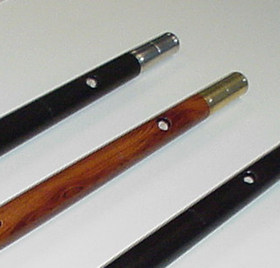|
Mopane (Colophospermum mopane)
|

Click on a picture to enlarge
|
Mopane is a beautiful mellow brown wood with a dark, straight grain. Machining and turning properties are excellent. The material has an ultra fine and uniform texture and can be brought to a polished marble like finish. It has a a dense compact structure. Density is 1100 to 1200 Kg/m3 making Mopane one of the most durable and hardest woods in the world and is the second hardest wood found in Africa This is a hard and heavy, moderately strong and very durable. This commercial wood is recently being used as an alternative to the rarer African Blackwood, and seems to have good tonal properties when used in musical instrument production
Mopane is also used of the production of charcoal in Africa and produces a wonderful aroma and flavors while cooking. While I donšt recommend burning your fife, Mopane may be excellent alternative for the fifer that has an allergic reaction to grenadilla or cocobolo.
More information about the Mopane Tree
The rugged and harsh terrain of the Southern African Bushveld is home to some of the most beautiful animal and plant life. Among these is the Mopane tree which is only found in the Mopane belt stretching through Southern Africa. One of the principal trees in the southern tropics of Africa, it forms dense thickets and even pure stands. Because of its abundance and its particular nutritious nature, the Mopane is a very important food plant - it is a favorite for elephants and other wild and domestic animals.
Mopane varies in size from small bushes up to a 10 m high tree. They are usually not cultivated or planted but grow naturally. In some areas, however, they are coppiced regularly and therefore look more like a cultivated crop. The leaves consist of two sickle-shaped leaflets which form a characteristic shape. The yellow green flowers are found in small clusters. The young fruit is fresh green and soft but it hardens into a flat brown pod that is kidney-shaped, there is only one seed inside and the pod does not open.
Undisturbed the tree grows to a height at which its nutritious leaves are beyond the reach of indigenous and domestic animals. Traditionally elephants pushed the tree over to obtain access to its leaves. The Mopane tree re-grows from its base with a foliage more accessible to the animal life.
The insect most associated with the Mopane tree is the Emperor moth, Imbrasia Belina, whose voracious larvea, the Mopane worm, lavishly feast on the Mopane tree. This protein rich worm is sought after by animals and humans who consume it fresh, in a stew, fried as crisps or sun-dried and even canned in tomato or piri-piri sauce.
|
Copyright 2003-2017, Peeler Fife Company, All Rights Reserved.
For problems with web functions (broken links, missing pages, etc.) contact
webmaster@peelerfifes.com
|
|